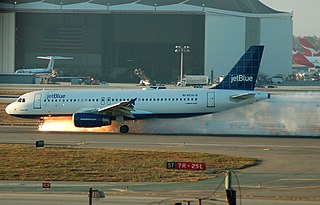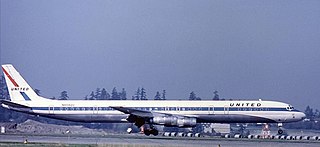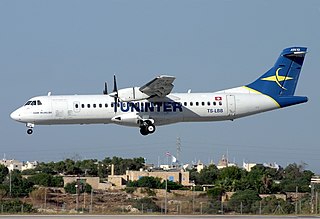
Luis Muñoz Marín International Airport is a joint civil-military international airport located in suburban Carolina, Puerto Rico, three miles (5 km) southeast of San Juan. It is named for Luis Muñoz Marín, Puerto Rico's first democratically elected governor, and was known as Isla Verde International Airport until it was renamed in February 1985. It is the busiest airport in the Caribbean region by passenger traffic. Over 4 million passengers board a plane at the airport per year according to the Federal Aviation Administration, making it the 48th busiest airport overseen by said federal agency.

United Airlines Flight 232 was a regularly scheduled United Airlines flight from Stapleton International Airport in Denver to O'Hare International Airport in Chicago, continuing to Philadelphia International Airport. On July 19, 1989, the DC-10 serving the flight crash-landed at Sioux Gateway Airport in Sioux City, Iowa, after suffering a catastrophic failure of its tail-mounted engine due to an unnoticed manufacturing defect in the engine's fan disk, which resulted in the loss of many flight controls. Of the 296 passengers and crew on board, 112 died during the accident, while 184 people survived. 13 of the passengers were uninjured. It was the deadliest single-aircraft accident in the history of United Airlines.

ALM Antillean Airlines, and later Air ALM, was the main airline of the Netherlands Antilles between its foundation in 1964 and its shut-down in 2001, operating out of Aruba, Bonaire, and Curaçao. It was based at Hato International Airport.

The original Overseas National Airways Inc (ONA) was an American airline, formed in June 1950 as a supplemental air carrier. It ceased operations on September 14, 1978. The airline started as Air Travel in 1946 and was renamed Calasia Air Transport the same year. The name changed to Overseas National in 1950 when it became a supplemental air carrier.

An emergency landing is a premature landing made by an aircraft in response to an emergency involving an imminent or ongoing threat to the safety and operation of the aircraft, or involving a sudden need for a passenger or crew on board to terminate the flight. It typically involves a forced diversion to the nearest or most suitable airport or airbase, or an off airport landing or ditching if the flight cannot reach an airfield. Flights under air traffic control will be given priority over all other aircraft operations upon the declaration of the emergency.

Pilot error generally refers to an accident in which an action or decision made by the pilot was the cause or a contributing factor that led to the accident, but also includes the pilot's failure to make a correct decision or take proper action. Errors are intentional actions that fail to achieve their intended outcomes. The Chicago Convention defines the term "accident" as "an occurrence associated with the operation of an aircraft [...] in which [...] a person is fatally or seriously injured [...] except when the injuries are [...] inflicted by other persons." Hence the definition of "pilot error" does not include deliberate crashing.

West Caribbean Airways Flight 708 was a charter flight that crashed in northwest Venezuela in the early hours of Tuesday, 16 August 2005, killing all 160 passengers and crew on board. The plane, a McDonnell Douglas MD-82, registration HK-4374X, was en route from Tocumen International Airport (PTY) in Panama City, Panama, to Martinique Aimé Césaire International Airport (FDF) in Fort-de-France, Martinique, France. While flying at 33,000 ft (10,000 m), the aircraft's speed gradually decreased until it entered an aerodynamic stall. The crew, probably under the mistaken belief that the aircraft had suffered a double engine flameout, did not take the necessary actions to recover from the stall. The confusion and lack of action resulted in the crash.

TACA Flight 110 was a scheduled international airline flight operated by TACA International Airlines, traveling from San Salvador to New Orleans, with a stopover in Belize City. On May 24, 1988, the flight encountered severe thunderstorm activity on its final approach to New Orleans International Airport. As a result, the brand new Boeing 737-300 suffered flameout in both engines while descending through a severe thunderstorm, but the pilots made a successful emergency landing on a grass levee adjacent to NASA's Michoud Assembly Facility, with no one aboard sustaining more than a few minor injuries, and with only minor hail damage to the intact aircraft. Following an on-site engine replacement, the jetliner took off from Saturn Boulevard, a road which had previously been an aircraft runway at Michoud. The aircraft was subsequently repaired and returned to service until it finally retired in 2016.

In aviation, a water landing is, in the broadest sense, an aircraft landing on a body of water. Seaplanes, such as floatplanes and flying boats, land on water as a normal operation. Ditching is a controlled emergency landing on the water surface in an aircraft not designed for the purpose, a very rare occurrence. Controlled flight into the surface and uncontrolled flight ending in a body of water are generally not considered water landings or ditching.

Southern Airways Flight 242 was a flight from Muscle Shoals, Alabama, to Atlanta, Georgia, with a stop in Huntsville, Alabama. On April 4, 1977, it executed a forced landing on Georgia State Route 381 in New Hope, Paulding County, Georgia, United States, after suffering hail damage and losing thrust on both engines in a severe thunderstorm.

In an internal combustion engine, fuel starvation is the failure of the fuel system to supply sufficient fuel to allow the engine to run properly, for example due to blockage, vapor lock, contamination by water, malfunction of the fuel pump or incorrect operation, leading to loss of power or engine stoppage. There is still fuel in the tank(s), but it is unable to get to the engine(s) in sufficient quantity. By contrast, fuel exhaustion is an occurrence in which the vehicle in question becomes completely devoid of usable fuel, with results similar to those of fuel starvation.

United Airlines Flight 173 was a scheduled flight from John F. Kennedy International Airport in New York City to Portland International Airport in Portland, Oregon, with a scheduled stop in Denver, Colorado. On December 28, 1978, the aircraft flying this route ran out of fuel while troubleshooting a landing gear problem and crashed in a suburban Portland neighborhood near NE 157th Avenue and East Burnside Street, killing 10 people on board.

Aeroflot Flight 366, also known as the Miracle on the Neva, was a water landing by a Tupolev Tu-124 of the Soviet state airline Aeroflot. The aircraft took off from Tallinn-Ülemiste Airport (TLL) at 08:55 on 21 August 1963 with 45 passengers and 7 crew on board. The aircraft was built in 1962 and was scheduled to fly to Moscow–Vnukovo (VKO) under the command of 27-year-old captain Victor Mostovoy. After takeoff the nose gear did not retract. Ground control diverted the flight to Leningrad (LED) – because of fog at Tallinn.

Garuda Indonesia Flight 421 was a scheduled domestic flight operated by Indonesian flag carrier Garuda Indonesia travelling about 625 km from Ampenan to Yogyakarta. On January 16, 2002, the flight encountered severe thunderstorm activity during approach to its destination, suffered flameout in both engines, and ditched in a shallow river, resulting in one fatality and several injuries.

Tuninter Flight 1153 was a Tuninter Airlines international flight from Bari International Airport in Bari, Italy, to Djerba-Zarzis Airport in Djerba, Tunisia. On 6 August 2005, the Tuninter ATR 72 ditched into the Mediterranean Sea about 18 miles (29 km) from the city of Palermo. Sixteen of the 39 people on board died. The accident resulted from fuel exhaustion due to the installation of fuel quantity indicators designed for the ATR 42 in the larger ATR 72. It was also Tuninter's first fatal accident in the 14-year history of the company.

US Airways Flight 1549 was a regularly scheduled US Airways flight from New York City's LaGuardia Airport to Charlotte and Seattle, in the United States. On January 15, 2009, the Airbus A320 serving the flight struck a flock of birds shortly after takeoff from LaGuardia, losing all engine power. Given their position in relation to the available airports and their low altitude, pilots Chesley "Sully" Sullenberger and Jeffrey Skiles decided to glide the plane to ditching on the Hudson River near Midtown Manhattan. All 155 people on board were rescued by nearby boats. There were no fatalities, although 100 people were injured, some seriously. The time from the bird strike to the ditching was less than four minutes.
















